Corrosion Fatigue Numerical Model for Austenitic and Lean-Duplex Stainless-Steel Rebars Exposed to Marine Environments
Abstract
1. Introduction
2. Experimental Procedure
2.1. Materials
2.2. Methodology
2.2.1. Fatigue Parameters
2.2.2. Corrosion Parameters
2.3. Calculation Procedure Overview
3. Results and Discussion
Corrosion Test
4. Future Work
5. Conclusions
- A semi-empirical numerical model has been developed to consider the contribution of corrosion during the fatigue process. This model is based on fracture mechanics and it is an iterative process adding the corrosion contribution to crack growth step by step. The inputs for this model came from direct measurement of corrosion rate, chemical composition, mechanical properties and standard fatigue requirements.
- The corrosion pushing factor FCP has been defined to consider the synergistic deterioration caused by simultaneous mechanical fatigue and pitting corrosion processes. It increases the number of effective loading cycles during the exposure time to compute fatigue damage as if it was due only to a mechanical process. Besides, it serves as an indicator of corrosion fatigue performance.
- Corrosion fatigue life decreased as the reinforcement diameter decreased. It can be due to a higher perimeter to cross-section area relationship, increasing the relative surface under exposure.
- The influence of corrosion was clearly higher at lower stress ranges, where the pitting corrosion became more dominant. Figure 4 and Figure 5 show the gap between the specimens at inert X0 and at tidal marine XS3 environments in terms of cycles to failure loss at each stress range level. The lower the stress range, the higher the cycle loss by coupled pitting corrosion.
- Stainless-steel reinforcements had better corrosion fatigue resistance than carbon steel reinforcements. The values of the corrosion pushing factor endorse the use of stainless-steel reinforcements in marine environments.
- Comparing 2001 LDSS with B500SD, the performance of 2001 LDSS was 1.5 times better. So, attending to the nickel content, 2001 LDSS is the best cost-performing and it can be a cost-effective alternative for reinforced concrete structures exposed to marine environments, considering material optimization at the design stage and maintenance savings during infrastructure exploitation.
- The 2001 LDSS presented the lowest corrosion fatigue resistance increment compared to 304L ASS, 316L ASS, 2304 LDSS, and 2205 DSS. Besides, 2205 DSS showed the best improvement, 1.5 times better than 2001 LDSS, which in turn was 1.5 times better than CS B500SD carbon steel.
- The FCP defined the fatigue service life and damage to structural elements in an easy way. It also served as a performance indicator for comparative purposes.
Author Contributions
Funding
Acknowledgments
Conflicts of Interest
References
- Bastidas, D.M.; González, J.A.; Feliu, S.; Cobo, A.; Miranda, J.M. A quantitative study of concrete-embedded steel corrosion using potentiostatic pulses. Corrosion 2007, 63, 1094–1100. [Google Scholar] [CrossRef]
- Reyes-Diaz, E.P.; Maldonado, B.E.; Almeray, C.F.; Bastidas, D.M.; Baltazar, Z.M.; Chacón, N.J.; Martínez-Villafañe, A.; Bastidas, J.M.; Gaona, T.C. Corrosion behavior of steel embedded in ternary concrete mixtures. Int. J. Electrochem. Sci. 2011, 6, 1892–1905. [Google Scholar]
- Lv, J.; Liang, T.; Wang, C.; Dong, L. Comparison of corrosion properties of passive films formed on coarse grained and ultrafine grained AISI 2205 duplex stainless steels. J. Electroan. Chem. 2015, 757, 263–269. [Google Scholar] [CrossRef]
- Al-Mehthel, M.; Al-Dulaijan, S.; Al-Idi, S.H.; Shameem, M.; Ali, M.R.; Maslehuddin, M. Performance of generic and proprietary corrosion inhibitors in chloride-contaminated silica fume cement concrete. Constr. Build. Mater. 2009, 23, 1768–1774. [Google Scholar] [CrossRef]
- Bastidas, D.M.; La Iglesia, V.M.; Criado, M.; Fajardo, S.; La Iglesia, A.; Bastidas, J.M. A prediction study of hydroxyapatite entrapment ability in concrete. Constr. Build. Mater. 2010, 24, 2646–2649. [Google Scholar] [CrossRef]
- Refait, P.; Jeannin, M.; Sabot, R.; Antony, H.; Pineau, S. Corrosion and cathodic protection of carbon steel in the tidal zone: Products, mechanisms and kinetics. Corros. Sci. 2015, 90, 375–382. [Google Scholar] [CrossRef]
- Corradi, M.; Schino, A.D.; Borri, A.; Rufini, R. A review of the use of stainless steel for masonry repair and reinforcement. Constr. Build. Mater. 2018, 181, 335–346. [Google Scholar] [CrossRef]
- Medina, E.; Medina, J.; Cobo, A.; Bastidas, D.M. Evaluation of mechanical and structural behavior of austenitic and duplex stainless steel reinforcements. Constr. Build. Mater. 2015, 78, 1–7. [Google Scholar] [CrossRef]
- ECCS. Good Design Practice—A Guideline for Fatigue Design; Handbook; European Convention for Constructional Steelwork; ECCS: Brussels, Belgium, 2000. [Google Scholar]
- BSI. BS6744 Stainless Steel Bars for the Reinforcement of and Use in Concrete-Requirements and Test Methods; Standard; British Standard Institution (BSI): London, UK, 2016. [Google Scholar]
- CARES. Stainless Reinforcing Steels; UK Cares: Sevenoaks, UK, 2011. [Google Scholar]
- Alonso, M.C.; Luna, F.J.; Criado, M. Corrosion behavior of duplex stainless steel reinforcement in ternary binder concrete exposed to natural chloride penetration. Constr. Build. Mater. 2019, 199, 385–395. [Google Scholar] [CrossRef]
- Bautista, A.; Paredes, E.C.; Velasco, F.; Alvarez, S.M. Corrugated stainless steels embedded in mortar for 9 years: Corrosion results of non-carbonated, chloride-contaminated samples. Constr. Build. Mater. 2015, 93, 350–359. [Google Scholar] [CrossRef]
- Du, Y.; Cullen, M.; Li, C. Structural effects of simultaneous loading and reinforcement corrosion on performance of concrete beams. Constr. Build. Mater. 2013, 39, 148–152. [Google Scholar] [CrossRef]
- Duarte, R.G.; Castela, A.S.; Neves, R.; Freire, L.; Montemor, M.F. Corrosion behavior of stainless steel rebars embedded in concrete: An electrochemical impedance spectroscopy study. Electrochim. Acta 2014, 124, 218–224. [Google Scholar] [CrossRef]
- Elsariti, S.M.; Haftirman. Behaviour of stress corrosion cracking of austenitic stainless steels in sodium chloride solutions. Procedia Eng. 2013, 53, 650–654. [Google Scholar] [CrossRef]
- Franco, N.; Biscaia, H.; Chastre, C. Experimental and numerical analyses of flexurally-strengthened concrete t-beams with stainless steel. Eng. Struct. 2018, 172, 981–996. [Google Scholar] [CrossRef]
- Pachón-Montaño, A.; Sánchez-Montero, J.; Andrade, C.; Fullea, J.; Moreno, E.; Matres, V. Threshold concentration of chlorides in concrete for stainless steel reinforcement: Classic austenitic and new duplex stainless steel. Constr. Build. Mater. 2018, 186, 495–592. [Google Scholar] [CrossRef]
- Pérez-Quiroz, J.T.; Terán, J.; Herrera, M.J.; Martínez, M.; Genescá, J. Assessment of stainless steel reinforcement for concrete structures rehabilitation. J. Constr. Steel Res. 2008, 64, 1317–1324. [Google Scholar] [CrossRef]
- Tsai, W.T.; Chen, M.S. Stress corrosion cracking behavior of 2205 duplex stainless steel in concentrated nacl solution. Corros. Sci. 2000, 42, 545–559. [Google Scholar] [CrossRef]
- Adedipe, O.; Brennan, F.; Kolios, A. Corrosion fatigue load frequency sensitivity analysis. Mar. Struct. 2015, 42, 115–136. [Google Scholar] [CrossRef]
- Calderón-Uríszar-Aldaca, I.; Briz, E.; Biezma, M.V.; Puente, I. A plain linear rule for fatigue analysis under natural loading considering the coupled fatigue and corrosion effect. Int. J. Fatigue 2019, 122, 141–151. [Google Scholar] [CrossRef]
- Ma, Y.; Xiang, Y.; Wang, L.; Zhang, J.; Liu, Y. Fatigue life prediction for aging RC beams considering corrosive environments. Eng. Struct. 2014, 79, 211–221. [Google Scholar] [CrossRef]
- Calderon-Uriszar-Aldaca, I.; Biezma, M. A plain linear rule for fatigue analysis under natural loading considering the sequence effect. Int. J. Fatigue 2017, 103, 386–394. [Google Scholar] [CrossRef]
- Calderon-Uriszar-Aldaca, I.; Biezma, M.; Matanza, A.; Briz, E.; Bastidas, D.M. Second-order fatigue of intrinsic mean stress under random loadings. Int. J. Fatigue 2020, 130, 105257. [Google Scholar] [CrossRef]
- Calderon-Uriszar-Aldaca, I. Fatigue of Structural Elements by Random Dynamic Actions in Aggressive Environment. Ph.D. Thesis, Universidad de Cantabria, Santander, Spain, 2014. [Google Scholar]
- Knop, M.; Heath, J.; Sterjovski, Z.; Lynch, S.P. Effects of cycle frequency on corrosion-fatigue crack growth in cathodically protected high-strength steels. Procedia Eng. 2010, 2, 1243–1252. [Google Scholar] [CrossRef]
- Gingell, A.D.B.; King, J.E. The effect of frequency and microstructure on corrosion fatigue crack propagation in high strength aluminium alloys. Acta Mater. 1997, 45, 3855–3870. [Google Scholar] [CrossRef]
- Palmgren, A.G. Die Lebensdauer von Kugellagern. Z. Ver. Dtsch. Ing. 1924, 14, 339–341. [Google Scholar]
- Miner, M. Cumulative damage in fatigue. J. Appl. Mech. 1945, 67, 159–164. [Google Scholar]
- Wöhler, A. Über die festigkeitsversuche mit eisen und stahl. Z. Bauwes. 1870, 20, 73–106. [Google Scholar]
- CEN. EN 1992-1-1 Design of Concrete Structures—Part 1-1: General Rules and Rules for Buildings; Standard; Comité Européen de Normalisation: Brussels, Belgium, 2015. [Google Scholar]
- AISC. Fatigue and Fracture Control in Steel Structures; Standard; American Institute of Steel Construction: Chicago, IL, USA, 2007. [Google Scholar]
- CEN. EN 1993-1-9 Design of Steel Structures—Part 1-9: Fatigue; Standard; Comité Européen de Normalisation: Brussels, Belgium, 2013. [Google Scholar]
- Paris, P.; Erdogan, F. A critical analysis of crack propagation laws. J. Fluids Eng. 1963, 85, 528–533. [Google Scholar] [CrossRef]
- Irwin, G. Analysis of stresses and strains near the end of a crack traversing a plate. J. Appl. Mech. 1957, 24, 361–364. [Google Scholar]
- Olguin Coca, F.J.; Loya Tello, M.U.; Gaona-Tiburcio, C.; Romero, J.A.; Martínez-Villafañe, A.; Maldonado, B.E.; Almeraya-Calderón, F. Corrosion Fatigue of Road Bridges: A review. Int. J. Electrochem. Sci. 2011, 6, 3438–3451. [Google Scholar]
- Adedipe, O.; Brennan, F.; Kolios, A. Review of corrosion fatigue in offshore structures: Present status and challenges in the offshore wind sector. Renew. Sustain. Energy Rev. 2016, 61, 141–154. [Google Scholar] [CrossRef]
- Calderon-Uriszar-Aldaca, I.; Briz, E.; Larrinaga, P.; Garcia, H. Bonding strength of stainless steel rebars in concretes exposed to marine environments. Constr. Build. Mater. 2018, 172, 125–133. [Google Scholar] [CrossRef]
- CEN. EN 206:2013+A1:2016 Concrete. Specification, Performance, Production and Conformity; Standard; Comité Européen de Normalisation: Brussels, Belgium, 2016. [Google Scholar]
- CEN. UNE-EN 10080 Steel for the Reinforcement of Concrete—Weldable Reinforcing Steel—General; Standard; Comité Européen de Normalisation: Brussels, Belgium, 2016. [Google Scholar]
- CEN. UNE-EN 10088-1 Stainless Steels—Part 1: List of Stainless Steels; Standard; Comité Européen de Normalisation: Brussels, Belgium, 2006. [Google Scholar]
- CEN. UNE-EN ISO 11130 Corrosion of Metals and Alloys—Alternate Immersion Test in Salt Solution; Standard; Comité Européen de Normalisation: Brussels, Belgium, 2011. [Google Scholar]
- Sánchez-Deza, A.; Bastidas, D.M.; Iglesia, A.L.; Mora, E.; Bastidas, J. Predicción de la vida útil en servicio de edificios de 50 años expuestos a ambientes marinos. Rev. Metal. 2018, 54, e111. [Google Scholar] [CrossRef]
- ECCS. Document 43—Recommendations for the Fatigue Design of Steel Structures; Handbook; European Convention for Constructional Steelwork; ECCS: Brussels, Belgium, 2011. [Google Scholar]
- CEN. UNE-EN ISO 15630-1 Steel for the Reinforcement and Prestressing of Concrete—Test Methods—Part 1: Reinforcing Bars, Wire rod and Wire; Standard; Comité Européen de Normalisation: Brussels, Belgium, 2011. [Google Scholar]
- CPH. EHE-08 Instrucción de Hormigón Estructural; Standard; Spanish Ministry of Public Works: Madrid, Spain, 2008. [Google Scholar]
- AENOR. UNE 112072 Laboratory Measurement of Corrosion Speed Using the Polarization Resistance Technique; Standard; Asociación Española de Normalización: Madrid, Spain, 2011. [Google Scholar]
- Hirt, M.; Bez, R.; Nussbaumer, A. Construction Métallique: Notions Fondamentales et Méthodes de Dimensionnement. Traité de Génie Civil, 1st ed.; Presses Polytechniques et Universitaires Romandes: Lausanne, Switzerland, 2006. [Google Scholar]
- Rocha, M.; Brühwiler, E. Prediction of fatigue life of reinforced concrete bridges using fracture mechanics. Proc. Bridge Maint. Saf. Manag. Resil. Sustain. 2012, 1, 3755–3761. [Google Scholar] [CrossRef]
- Herwig, A. Reinforced Concrete Bridges under Increased Railway Traffic Loads: Fatigue Behaviour and Safety Measures. Ph.D. Thesis, École Polytechnique Fédérale de Lausanne, Lausanne, Switzerland, 2008. [Google Scholar] [CrossRef]
- BSI. BS 7910:2005 Guide to Methods for Assessing the Acceptability of Flaws in Metallic Structures; Standard; British Standard Institution: London, UK, 2005. [Google Scholar]
- Zhao, Z.; Fu, L. The probability distribution of pitting for accelerated corrosion reinforcement. Case Stud. Constr. Mater. 2018, 9, e00193. [Google Scholar] [CrossRef]
- Andrade, C.; Gonzalez, J.A. Quantitative measurement of corrosion rate of reinforcing steels embedded in concrete using polarization resistance measurements. Werkst. Korros. 1978, 29, 515–519. [Google Scholar] [CrossRef]
- Andrade, C.; Alonso, C. Corrosion rate monitoring in the laboratory and onsite. Constr. Build. Mater. 1996, 10, 315–328. [Google Scholar] [CrossRef]
- González, J.; Andrade, C.; Alonso, C.; Feliu, S. Comparison of rates of general corrosion and maximum pitting penetration on concrete embedded steel reinforcement. Cem. Concr. Res. 1995, 25, 257–264. [Google Scholar] [CrossRef]
- Basquin, O. The exponential law of endurance tests. Proc. Am. Soc. Test. Mater. 1910, 10, 625–630. [Google Scholar]
- Briz, E.; Biezma, M.V.; Bastidas, D.M. Stress corrosion cracking of new 2001 lean-duplex stainless steel reinforcements in chloride contained concrete pore solution: An electrochemical study. Constr. Build. Mater. 2018, 192, 1–8. [Google Scholar] [CrossRef]
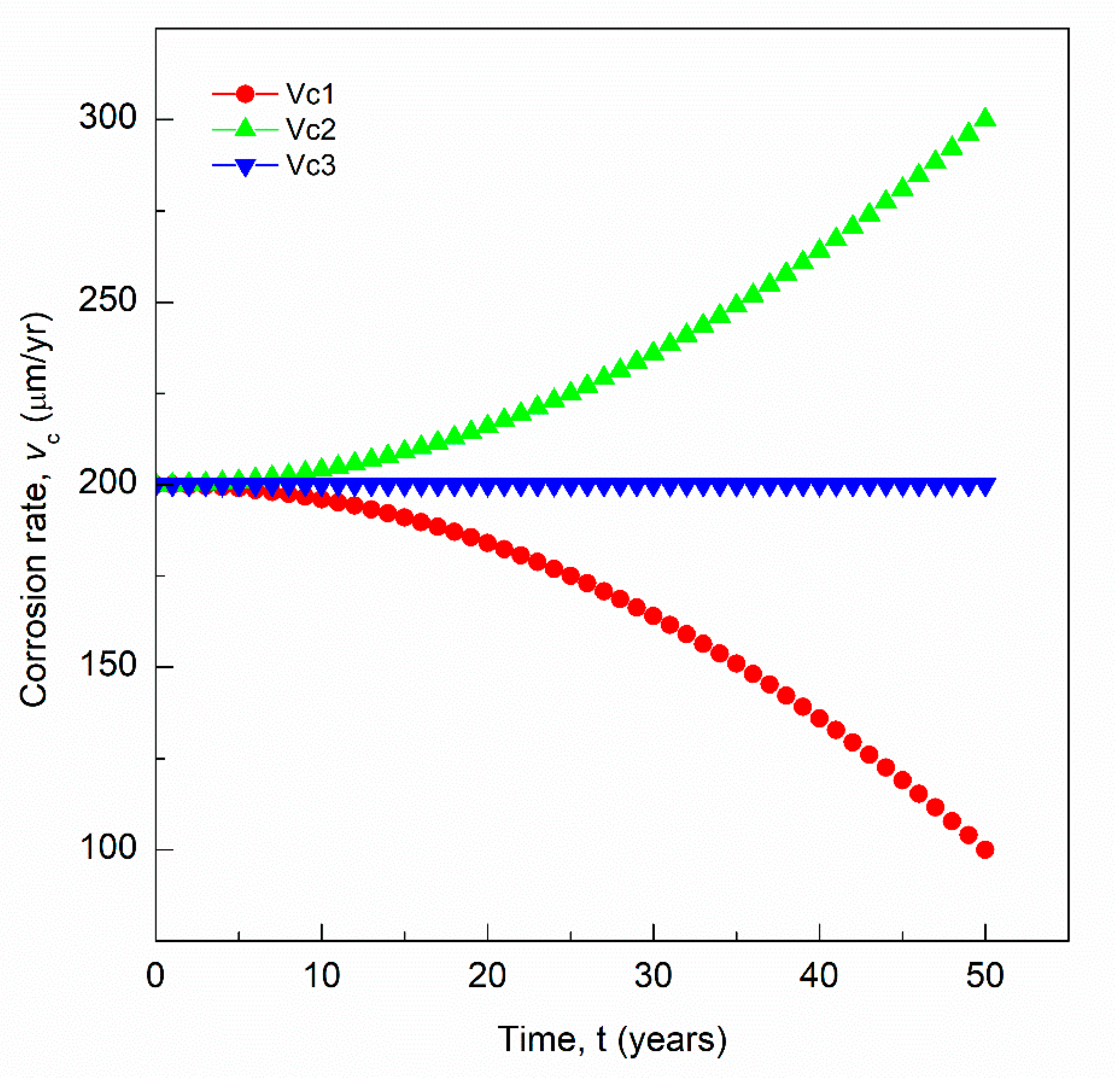
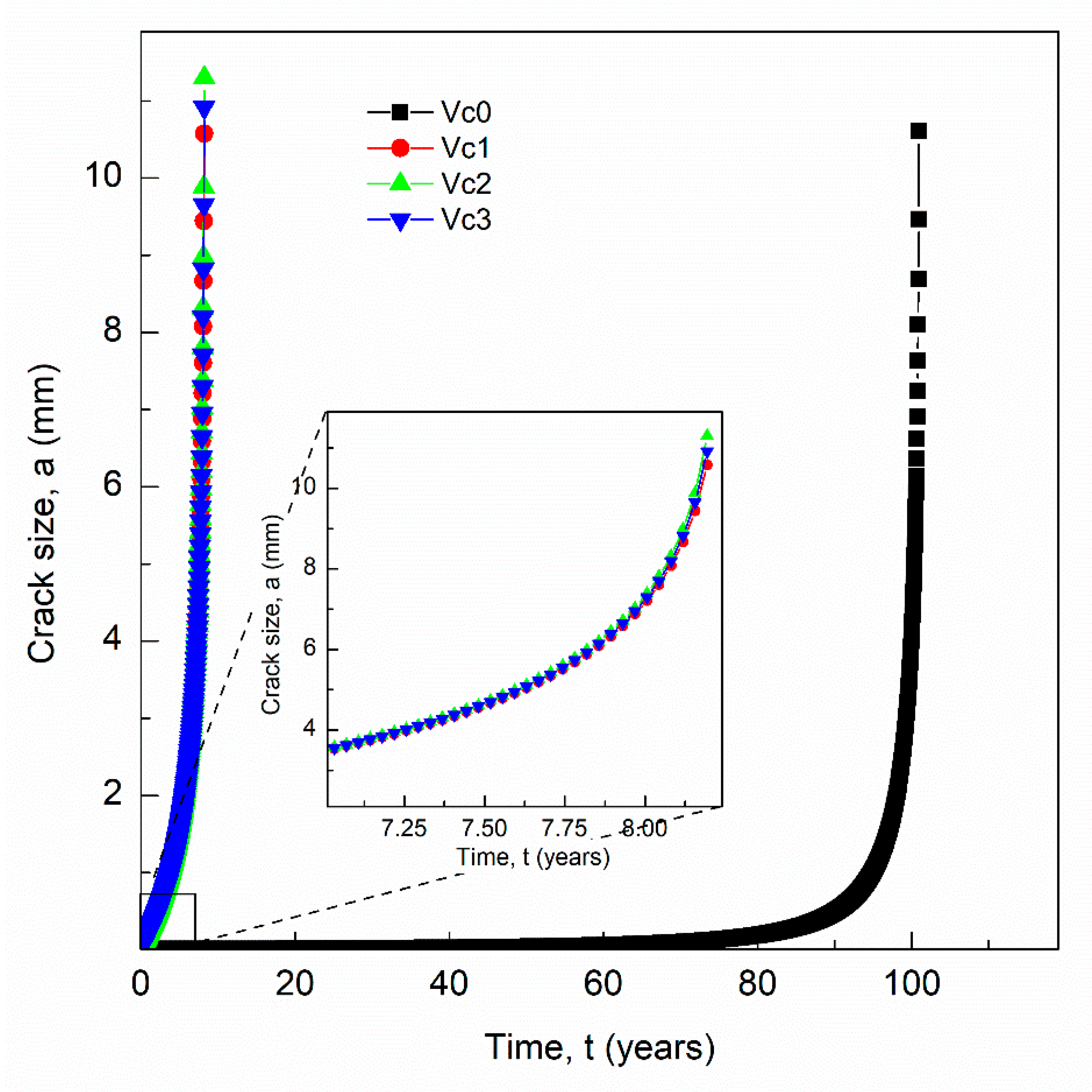


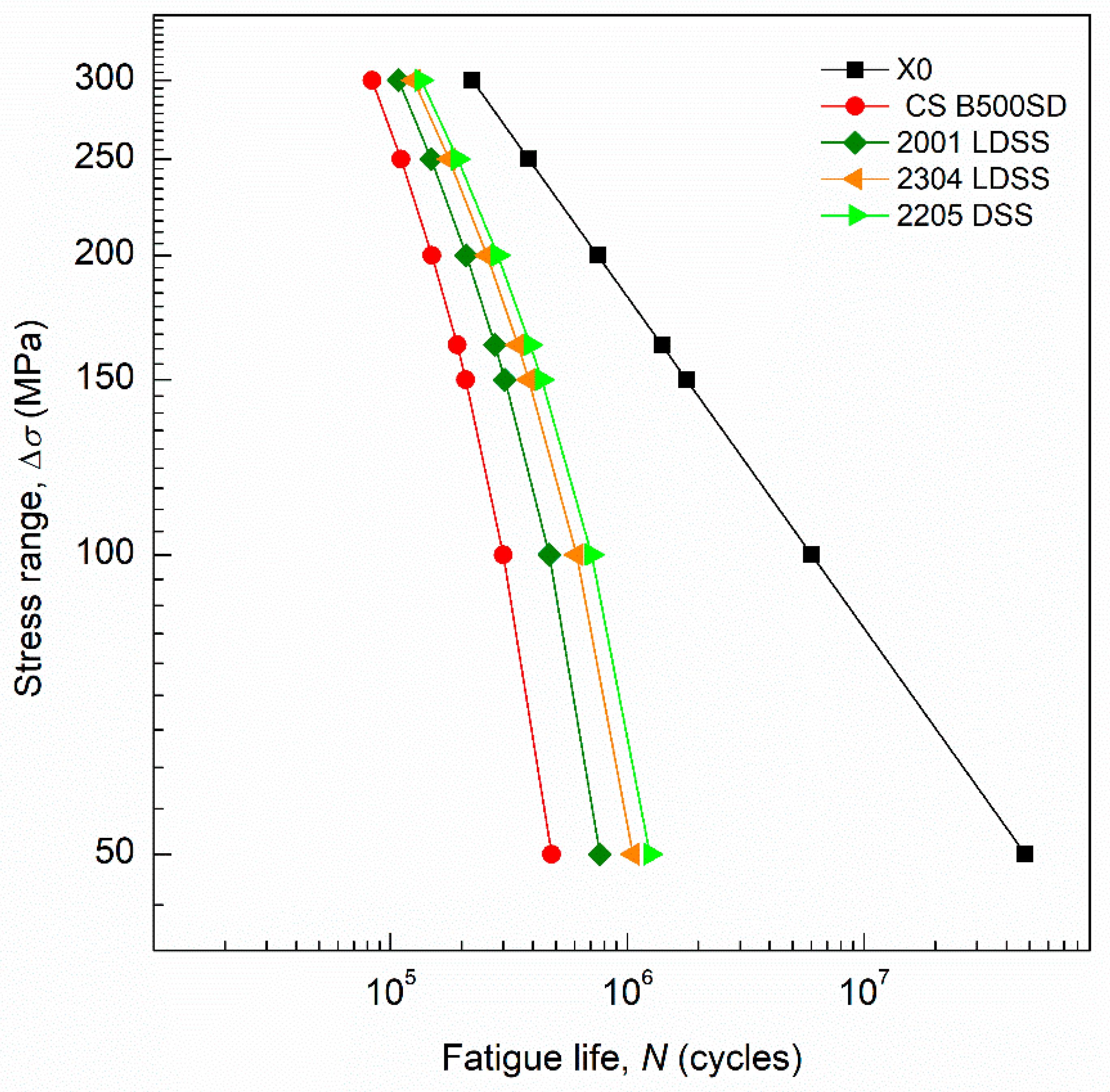
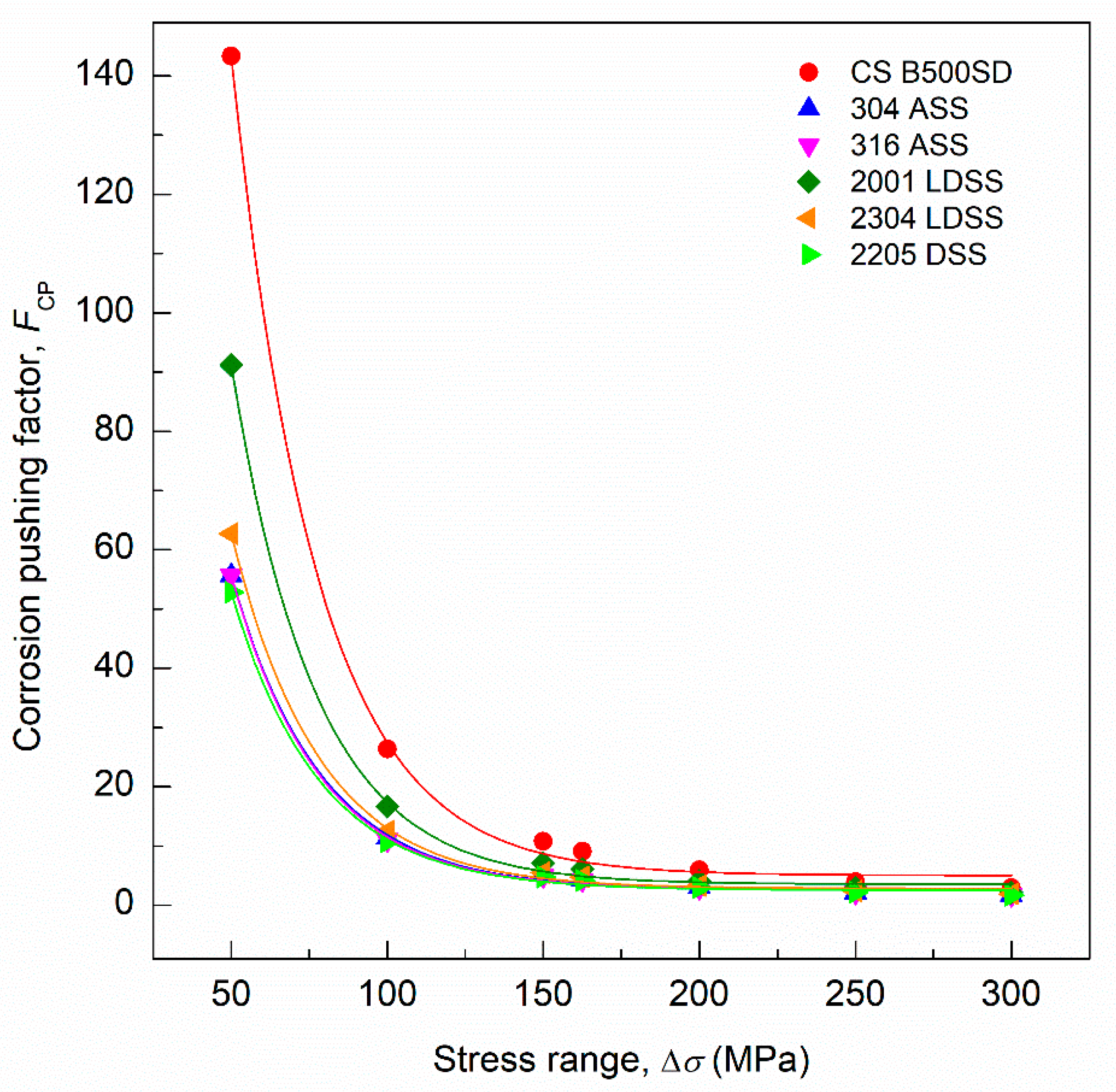
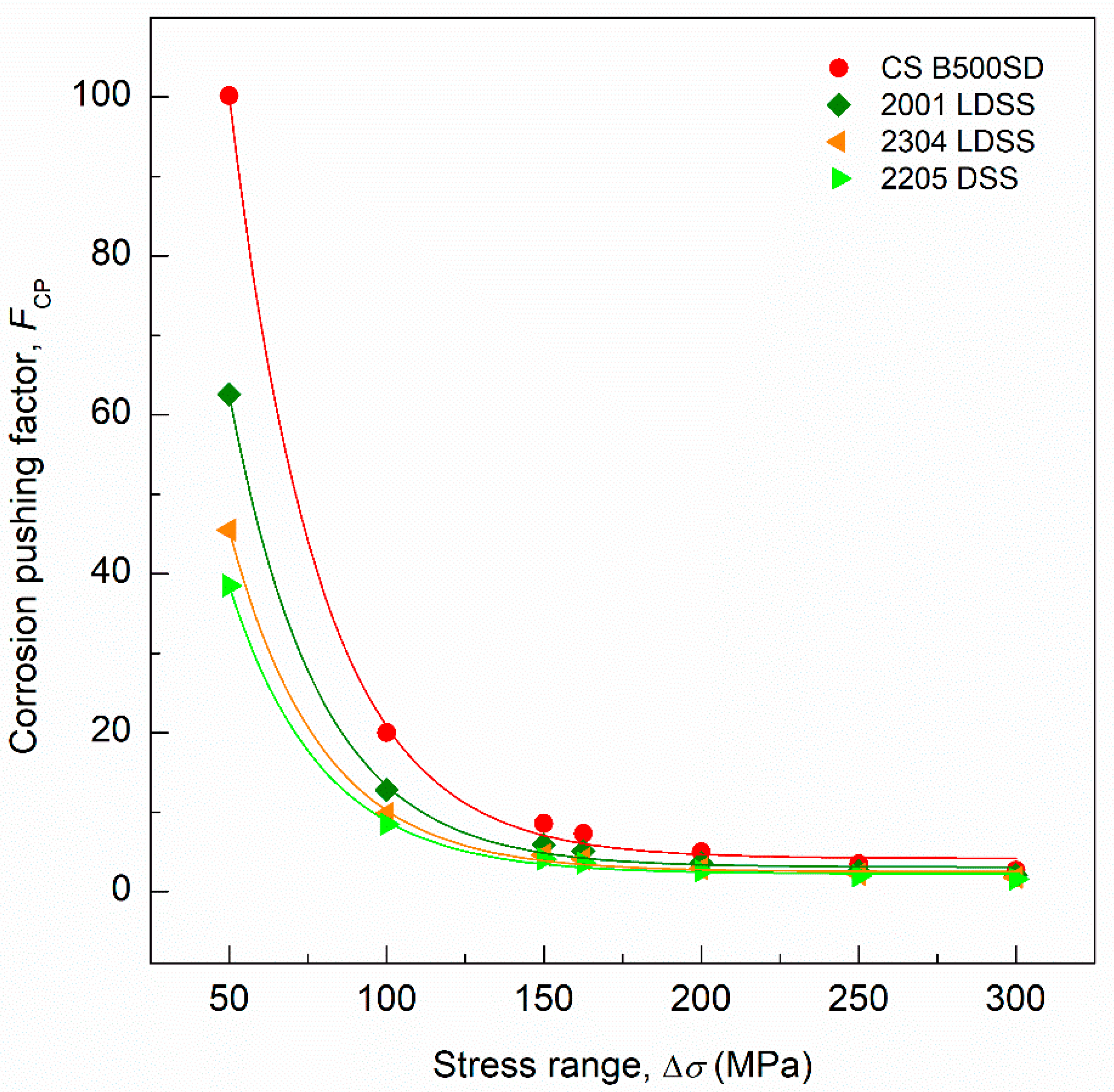
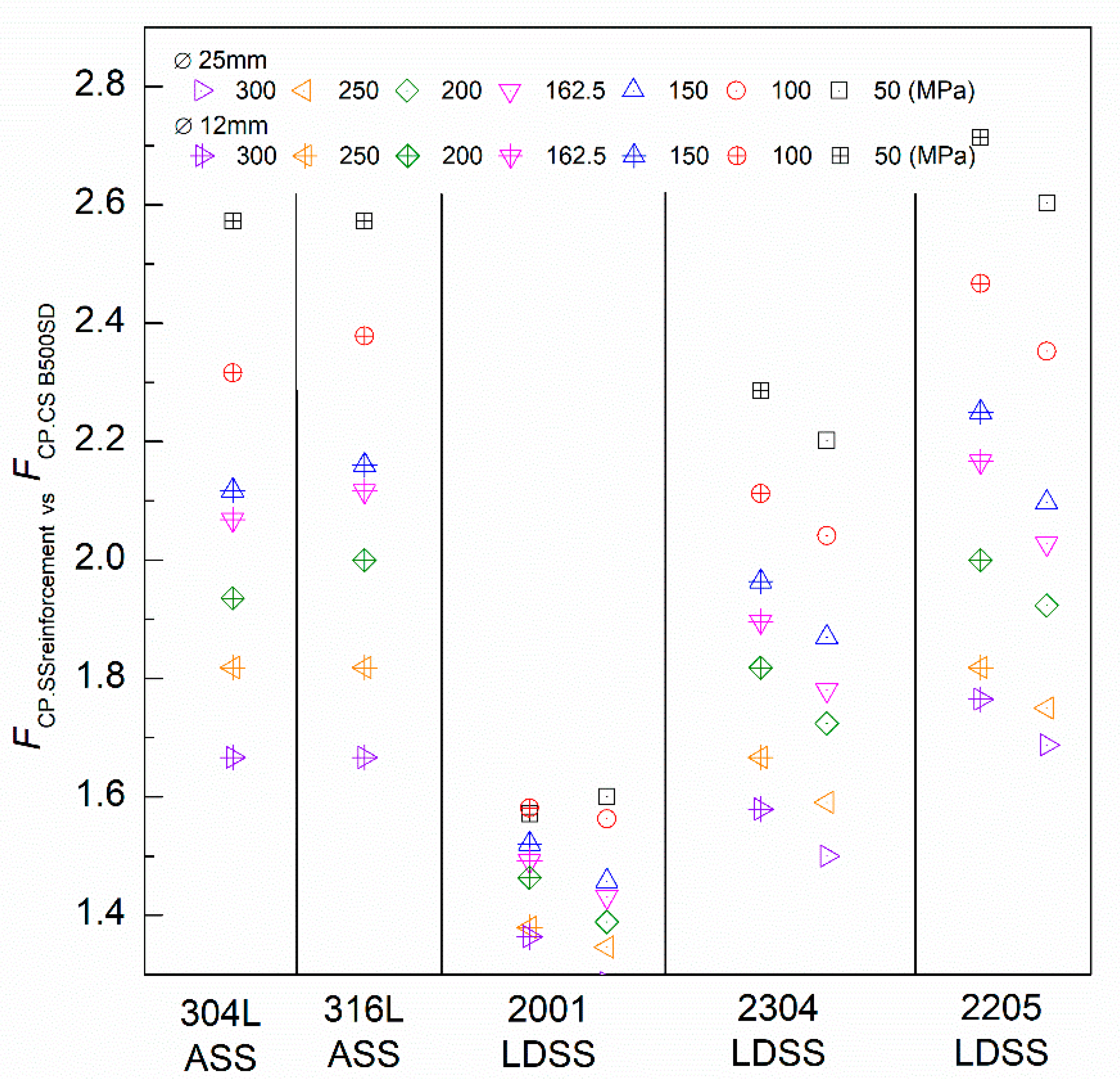
| Steel Grade | C | Si | Mn | P | S | Cr | Ni | Mo | N | Cu |
|---|---|---|---|---|---|---|---|---|---|---|
| CS B500SD | 0.24 | 0.22 | 0.72 | 0.055 | <0.01 | 0.13 | 0.13 | - | - | 0.18 |
| 304L ASS | 0.02 | 0.28 | 1.41 | 0.034 | 0.023 | 18.1 | 7.9 | 0.22 | 0.05 | 0.33 |
| 316L ASS | 0.016 | 0.25 | 1.18 | 0.03 | 0.001 | 18.5 | 10.1 | 2.5 | 0.11 | - |
| 2205 DSS | 0.02 | 0.34 | 1.61 | 0.035 | 0.001 | 22.2 | 4.7 | 3.5 | 0.22 | 0.22 |
| 2304 LDSS | 0.02 | 0.35 | 0.81 | 0.029 | 0.015 | 22.8 | 4.5 | 0.29 | 0.14 | 0.31 |
| 2001 LDSS | 0.03 | 0.75 | 4.19 | 0.023 | <0.01 | 20.1 | 1.78 | 0.22 | 0.17 | 0.08 |
| Nf | ≥2 × 106 Cycles |
| σsup | 300 MPa |
| Δσ | 300 MPa |
| f | 1 ≤ f ≤ 200 Hz |
| ΔNm | Nf |
|---|---|
| 100,000 | 2,000,000 |
| 50,000 | 2,000,000 |
| 10,000 | 2,020,000 |
| 5000 | 2,020,000 |
| 2000 | 2,020,000 |
| 1000 | 2,019,000 |
| 750 | 2,019,000 |
| Steel (Grade) | icorr (μA/cm2) | Mass Loss, Mdd (mg × dm2/Day) | vcorr,g (μm/Year) | vcorr,p (μm/Year) |
|---|---|---|---|---|
| B500SD | 0.155 | 3.88 | 18.041 | 180.41 |
| 304L ASS | 0.05 | 1.25 | 5.82 | 58.2 |
| 316L ASS | 0.05 | 1.21 | 5.626 | 56.26 |
| 2205 DSS | 0.045 | 1.14 | 5.318 | 53.18 |
| 2304 LDSS | 0.06 | 1.43 | 6.646 | 66.46 |
| 2001 LDSS | 0.09 | 2.12 | 9.877 | 98.77 |
| Steel (Grade) | vcorr,p (μm/Year) | Scale Factor (#) | vcorr,p * (μm/Year) |
|---|---|---|---|
| B500SD | 180.41 | 2.77 | 500.00 |
| 304L ASS | 58.20 | 161.29 | |
| 316L ASS | 56.26 | 155.91 | |
| 2205 DSS | 53.18 | 147.39 | |
| 2304 LDSS | 66.46 | 184.17 | |
| 2001 LDSS | 98.77 | 273.72 |
| Δσ (MPa) | Control | B500SD | 304L ASS | 316L ASS | 2001 LDSS | 230 LDSS | 2205 DSS |
|---|---|---|---|---|---|---|---|
| 50 | 3.80 × 107 | 2.65 × 105 | 6.82 × 105 | 6.82 × 105 | 4.17 × 105 | 6.06 × 105 | 7.19 × 105 |
| 100 | 4.75 × 106 | 1.80 × 105 | 4.16 × 105 | 4.26 × 105 | 2.84 × 105 | 3.79 × 105 | 4.45 × 105 |
| 150 | 1.41 × 106 | 1.30 × 105 | 2.78 × 105 | 2.83 × 105 | 1.98 × 105 | 2.55 × 105 | 2.93 × 105 |
| 162.5 | 1.11 × 106 | 1.21 × 105 | 2.53 × 105 | 2.57 × 105 | 1.82 × 105 | 2.33 × 105 | 2.66 × 105 |
| 200 | 5.93 × 105 | 9.88 × 104 | 1.92 × 105 | 1.95 × 105 | 1.43 × 105 | 1.79 × 105 | 2.00 × 105 |
| 250 | 3.03 × 105 | 7.60 × 104 | 1.35 × 105 | 1.37 × 105 | 1.05 × 105 | 1.27 × 105 | 1.41 × 105 |
| 300 | 1.76 × 105 | 5.92 × 104 | 9.77 × 104 | 9.90 × 104 | 7.90 × 104 | 9.30 × 104 | 1.01 × 105 |
| Δσ (MPa) | Control | CS B500SD | 2001 LDSS | 230 LDSS | 2205 DSS |
|---|---|---|---|---|---|
| 50 | 4.81 × 107 | 4.80 × 105 | 7.68 × 105 | 1.06 × 106 | 1.25 × 106 |
| 100 | 6.01 × 106 | 3.00 × 105 | 4.68 × 105 | 6.12 × 105 | 7.08 × 105 |
| 150 | 1.78 × 106 | 2.08 × 105 | 3.04 × 105 | 3.84 × 105 | 4.35 × 105 |
| 162.5 | 1.40 × 106 | 1.91 × 105 | 2.77 × 105 | 3.45 × 105 | 3.90 × 105 |
| 200 | 7.51 × 105 | 1.50 × 105 | 2.09 × 105 | 2.56 × 105 | 2.84 × 105 |
| 250 | 3.84 × 105 | 1.11 × 105 | 1.48 × 105 | 1.76 × 105 | 1.93 × 105 |
| 300 | 2.22 × 105 | 8.37 × 104 | 1.08 × 105 | 1.25 × 105 | 1.35 × 105 |
| Δσ (MPa) | B500SD | 304L ASS | 316L ASS | 2001 LDSS | 2304 LDSS | 2205 DSS |
|---|---|---|---|---|---|---|
| 50 | 143.3 | 55.7 | 55.7 | 91.2 | 62.7 | 52.8 |
| 100 | 26.4 | 11.4 | 11.1 | 16.7 | 12.5 | 10.7 |
| 150 | 10.8 | 5.1 | 5.0 | 7.1 | 5.5 | 4.8 |
| 162.5 | 9.1 | 4.4 | 4.3 | 6.1 | 4.8 | 4.2 |
| 200 | 6.0 | 3.1 | 3.0 | 4.1 | 3.3 | 3.0 |
| 250 | 4.0 | 2.2 | 2.2 | 2.9 | 2.4 | 2.2 |
| 300 | 3.0 | 1.8 | 1.8 | 2.2 | 1.9 | 1.7 |
| Δσ (MPa) | B500SD | 2001 LDSS | 2304 LDSS | 2205 DSS |
|---|---|---|---|---|
| 50 | 100.2 | 62.6 | 45.5 | 38.5 |
| 100 | 20.0 | 12.8 | 9.8 | 8.5 |
| 150 | 8.6 | 5.9 | 4.6 | 4.1 |
| 162.5 | 7.3 | 5.1 | 4.1 | 3.6 |
| 200 | 5.0 | 3.6 | 2.9 | 2.6 |
| 250 | 3.5 | 2.6 | 2.2 | 2.0 |
| 300 | 2.7 | 2.1 | 1.8 | 1.6 |
© 2020 by the authors. Licensee MDPI, Basel, Switzerland. This article is an open access article distributed under the terms and conditions of the Creative Commons Attribution (CC BY) license (http://creativecommons.org/licenses/by/4.0/).
Share and Cite
Calderón-Uríszar-Aldaca, I.; Briz, E.; Matanza, A.; Martin, U.; Bastidas, D.M. Corrosion Fatigue Numerical Model for Austenitic and Lean-Duplex Stainless-Steel Rebars Exposed to Marine Environments. Metals 2020, 10, 1217. https://doi.org/10.3390/met10091217
Calderón-Uríszar-Aldaca I, Briz E, Matanza A, Martin U, Bastidas DM. Corrosion Fatigue Numerical Model for Austenitic and Lean-Duplex Stainless-Steel Rebars Exposed to Marine Environments. Metals. 2020; 10(9):1217. https://doi.org/10.3390/met10091217
Chicago/Turabian StyleCalderón-Uríszar-Aldaca, Iñigo, Estibaliz Briz, Amaia Matanza, Ulises Martin, and David M. Bastidas. 2020. "Corrosion Fatigue Numerical Model for Austenitic and Lean-Duplex Stainless-Steel Rebars Exposed to Marine Environments" Metals 10, no. 9: 1217. https://doi.org/10.3390/met10091217
APA StyleCalderón-Uríszar-Aldaca, I., Briz, E., Matanza, A., Martin, U., & Bastidas, D. M. (2020). Corrosion Fatigue Numerical Model for Austenitic and Lean-Duplex Stainless-Steel Rebars Exposed to Marine Environments. Metals, 10(9), 1217. https://doi.org/10.3390/met10091217







